#stereographic card
Text
Butterflies in stereo-view 1870s
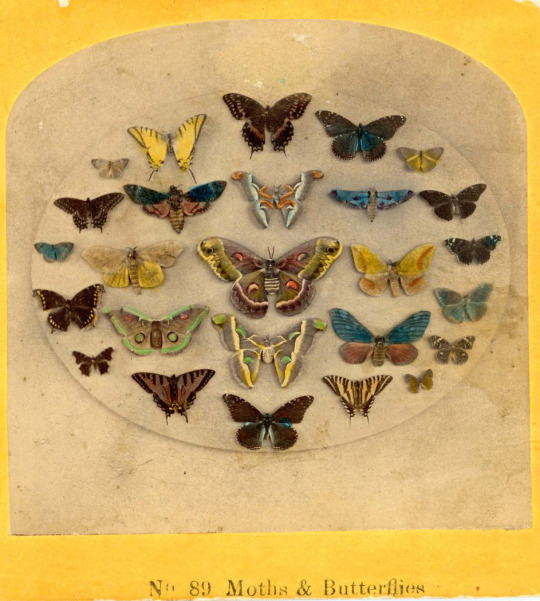
Right side of stereographic card nº 89 (Kilburn Brothers)
The Kilburn Brothers. A partnership between Benjamin West Kilburn and his brother Edward Kilburn of Littleton, New Hampshire (USA). One of the most significant of the American photographers and publishers…
View & read more on WordPress
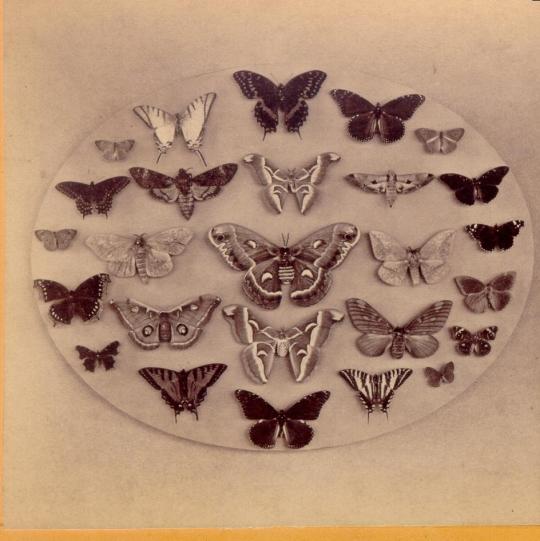
Kilburn Brothers, No. 89. Moths and Butterflies; no date (half of stereo-card) | courtesy Alan Griffiths : Luminous-Lint (LL/37775-6)
View more on WordPress
#Kilburn brothers#butterflies#Edward Kilburn#farfalle#Schmetterling#Benjamin W. Kilburn#hand painted#mariposas#papillon#schmetterlinge#stereo card#stereo view#stereographic card#stereoscopic card#1870s
116 notes
·
View notes
Text
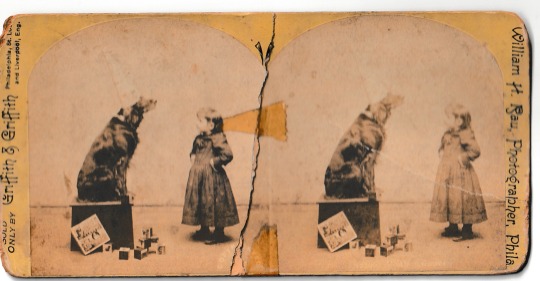
c. 1893
1 note
·
View note
Text
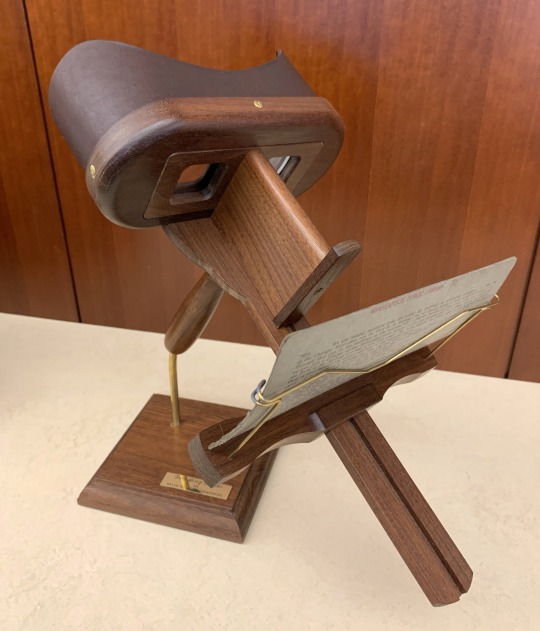
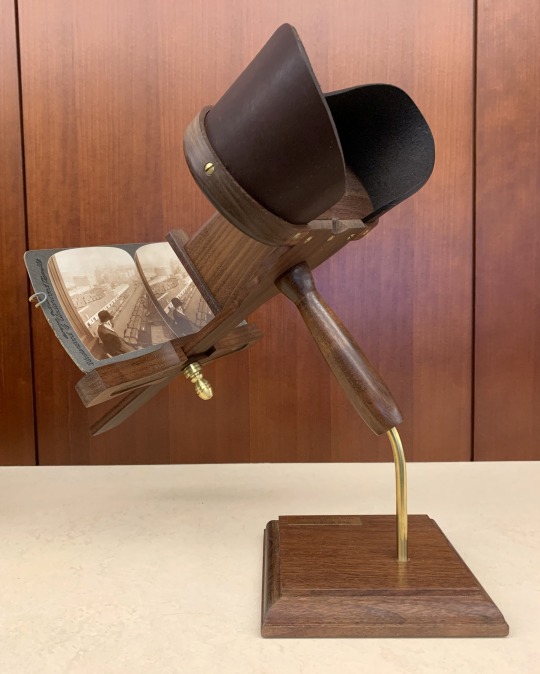
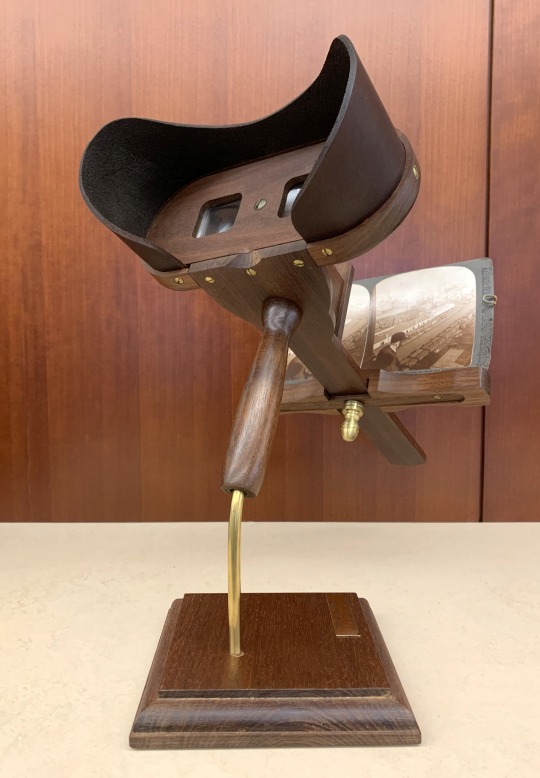
Red Wing Stereoscope
Recently, Special Collections received a donation of two pristine Red Wing Stereoscopes made by Luther Askeland in the 1980s, donated by his daughter.
The Red Wing Viewer was designed by Craig Daniels, of Red Wing, Minnesota, in 1982. The beautiful new design wasn't just another reproduction of the classic stereoscope designed by poet and physician Oliver Wendell Holmes in 1861. Daniels' design corrected many of the problems of other mass produced stereoscopes--the card holder didn't wobble, the hood was big enough for eyeglasses, the lenses didn't slide in their mounts, it was sturdy, and made of beautiful wood with a leather hood. When demand for the Red Wing Viewers picked up in 1985, Daniels brought in Luther Askeland to fabricate and assemble the viewers in his woodworking shop in nearby Welch, Minnesota. Askeland had already been supplying Daniels with walnut wood and some other wood parts, but he soon was doing most of the work--following over 16 pages of detailed instructions and figuring out the best and most efficient way to make each part. Craig Daniels continued to supply the glass lenses and brass parts, and Askeland's daughter, Kari, who donated the stereoscopes, helped with the packaging and shipping. The price of a Red Wing Viewer in 1986, without stand, was $68.00.
Visit Special Collections at Minneapolis Central Library to view photos from our stereoscope collection in a Red Wing Viewer. Some stereograph images are available to view in the HCL Digital Collections.
11 notes
·
View notes
Text

Underwood & Underwood Publishers stereograph card. Personal collection and scan.
(61) The favorite drive, Champs Elysses—from Arch of Triumph to Place de la Concorde—Paris, France. Copyright 1900 by Underwood & Underwood. New York. London. Toronto-Canada. Ottawa-Kansas. Sun Sculpture Trade Mark. Works and Studios ~ Arlington, N.J. Littleton, N.H. Washington, D.C.
#stereograph#champs elysees#paris#france#europe#photography#antique#vintage#light academia#aesthetic#dark academia#personal collection#1900s#20th century#historical photography#historical#underwood & underwood
3 notes
·
View notes
Text
USS Texas (1892) taking on coal from a lighter, on August 3, 1898.
The original photograph was copyright 1898 by B.L. Singley, and published on a stereograph card by the Keystone View Company.

NHHC: NH 82646
#USS Texas (1892)#USS Texas#Second Rate Battleship#Battleship#Warship#Ship#United States Navy#U.S. Navy#US Navy#USN#Navy#Spanish-American War#Spanish American War#New York City#New York#East Coast#August#1898#my post
17 notes
·
View notes
Photo

“Loaded coal barges and steamers on the Monongahela river, Pittsburg, Pa., U.S.A.” H.C. White Co., 1907 (minor processing by Jake Wood, 2023).
Library of Congress Prints & Photographs Online Catalog
Stereograph Card Collection
2 notes
·
View notes
Photo

The Ghost in the Stereoscope, 1856
Founded in 1854, the London Stereoscopic and Photographic Company was a major publisher of stereographs-cards with two nearly identical photographs mounted side by side that can be viewed through a binocular device to create an illusion of depth. [...] Among the most popular themes were courtship, marriage, unrequited love, bereavement, children sleeping or praying, fairy tales, fortune telling, and supernatural scenes involving ghosts or spirits. Metropolitan Museum of Art.
#photography#1800s#history#the ghost in the stereoscope#stereoscope#old timey entertainment#ghost#supernatural art
2 notes
·
View notes
Text
Markeaton Street Gallery - an overview
Markeaton Street gallery, otherwise known as Msg., is a gallery space curated by Dr. Gemma Marmalade and Elisha-Mai Gascoigne (myself). It exhibits a permanent collection and a changing exhibition programmes of contemporary art at the Markeaton Campus at University of Derby. Msg. opened it’s doors for the first time to the public as part of FORMAT festival in March 2023, it held 5 exhibitions on the ground and first floor showcasing work from a wide variety of artists.
How love lives in two places -
How love lives in two places is a multi- and trans-disciplinary exhibition of over thirty artists describing the experimental boundaries of both photography and place. With a title extracted from the poetry of Clark County's Poet Laureate, Angela M. Brommel, How love lives in two places is a visual dialogue between Derby, UK and Las Vegas, Nevada, USA. Students and faculty of the University of Derby School of Arts have worked together with their counterparts at Nevada State College Office for the Arts, alongside friendships made with seminal and emerging artists residing and working in the Las Vegas Valley. The partnership fostered between both institutions is supported by the generous patronage of James Stanford and Lynn Morris.
The official launch opened at 6pm on the 17th March and included a performance from Gemma Marmalade at 6:30, followed by speeches shortly after. It stayed open until 21st April which was an extended opening due to popular demand and footfall we had throughout the gallery being open. How Love Lives in Two Places was a great opening for Markeaton Street gallery as it was something that was close to home for both myself and Gemma and engaged a wider audience due to our very special and well respected guests from Las Vegas: American artist James Stanford, Senior Advisor & Executive Director for the Arts at Nevada State College as well as being Clark County Poet Laureate Angela M. Brommel, and PR Manager Laura Henkel.
During the summer of 2022, I was fortunate enough to be able to go across to Las Vegas to work alongside Nevada State College staff and students. Whilst out there we worked as a collective to produce an exhibition dedicated to the work we’d made based on what it feels like to be home. Due to the participants of the trip being from a variety of different media based works creating an amazing collection of work from all different medians.
My work within How love lives in two places -
The work that I created was a dedication to stereographic photography which is a popular form of photography in the 19th century. It used a special camera where photographers would take two nearly identical images which once they were printed side by side, would appear as a three dimensional image when viewed through a set of special lenses called a stereoscope. The stereoscopes go back all the way to 1830s however, it wasn’t until the Great Exhibition of 1851 that a practical method of publishing stereo images were introduced to the public. In typical use, stereoscopic images would be viewed as parlour entertainment. In an era before films or television, families would experience what it was like to see distant landmarks or exotic landscapes by passing around the stereoscope. Stereo cards were often sold in numbered sets, so consumers could easily buy a series of views related to a particular theme. Some photographs that might be impressive when shot with a normal camera can seem thrilling, if not terrifying, when viewed with the full stereoscopic effect. Alexander Gardner used a stereoscopic camera when he took his classic photographs at Antietam during the Civil War.
While Sir Charles Wheatstone first described stereoscopic lens, it was Sir David Brewster who further developed the idea in 1849. The production of the stereograph entailed making two images with almost alike similarity, usually pictured by two cameras placed 2.5 inches apart to simulate the position of the human eye. They were then mounted by the positive prints side by side laterally on a stiff backing. The two images were brought together by the effort of the human brain to create an illusion of three dimensionality.
One thing I noticed about Las Vegas was how strong the sun was compared to the UK. Along with this, naturally, the landscapes are different too as the climates are polar opposites. I wanted to incorporate both of these things within my work but mainly show how different the landscapes changed within such a short period of time. After monitoring the climates, I chose to have a 2-hour time period for my project as it had a better chance of showing exactly how the landscapes move due to the weather climates, I chose 12:30pm and 2:30pm. Because the project is about things that remind us of home, I decided to make my work into postcard sizes to symbolise the postcards you would send home when you go a great distance away from what you associate to be home.


0 notes
Photo

Top, Caroline S. Brooks, The dreaming Iolanthe, King Rene's daughter, from Henri Herz a study in butter, 1876, photographic print on stereo card : stereograph. Via. More. Bottom, Josh Kline, How Much Is That Intern In The Window? (source : DISimages stock image library). Via.
--
There is something uniquely convincing about the perceptions that occur to you when you are in love. They seem truer than other perceptions, and more truly your own, won from reality at personal cost. Greatest certainty is felt about the beloved as necessary complement to you. Your powers of imagination connive at this vision, calling up possibilities from beyond the actual. All at once a self never known before, which now strikes you as the true one, is coming into focus. A gust of godlikeness may pass through you and for an instant a great many things look knowable, possible and present. Then the edge asserts itself. You are not a god. You are not that enlarged self. Indeed, you are not even a whole self, as you now see. Your new knowledge of possibilities is also a knowledge of what is lacking in the actual.
Anne Carson, from Eros the Bittersweet, 1986. Via.
--
Indeed, I know quite a number of Lacanian psychoanalysts in Argentina who are devoted tango dancers. They will tell you that tango is about death and sexuality, adding that on the dance floor you find only two types of people: those who are in analysis and those who need analysis. Ask any Argentinean tango dancer about the origins of this rhythmic, glamorous, sensuous dance and they will tell you that tango is not a dance but a feeling, that even before the music was created, tango already existed as the expression of a man and a woman’s mutual need to embrace. Tangueros wax lyrical and believe that tango is not a dance but an emotion. Tango is syncopated love, pure attitude. With the same passion, they deny the hard historical evidence regarding tango’s origins in gender-bending and class-crossing. Tango, born in the late nineteenth century, is the result of a mixture of cultures. It appeared in the cafes, gambling houses, and waiting rooms of brothels in the poorest barrios of Buenos Aires. Most of the time, destitute immigrants and local compadritos would dance with other men. The first women to be included danced tango dressed as men with other women in drag.
Patricia Gherovici, from Why I Did Not Write a Book on Lacan and Tango, for e-flux, March 29, 2023
1 note
·
View note
Text

Lanterman House
Lanterman House is one of the few pre-1920 residences in La Canada Flintridge. This home was built by the Lanterman family in 1915. It is listed on the National Register of Historic Places. A tour is available, but only if you call ahead. The cost is $5. The house is open for tours on Tuesdays and Thursdays from 1-4 p.m. There is a small private parking lot.
In addition to the exterior of the Lanterman House, visitors can see the gardens, which have been meticulously restored. These gardens are a representation of turn-of-the-century Southern California living. They include specimens and native plant ornaments. Visitors can also take part in an annual gingerbread contest. Some of the original plants and flowering shrubs are still there.
Lanterman House also has an extensive archive. Among its materials are photographs and oral histories of Valley residents. You can find out about the Lanterman family, as well as the history of the Crescenta-Canada Valley. One of the most notable residents was Frank D. Lanterman, who served as a California State Assemblyman. He was also an accomplished theater organist.
The house is situated on 1.4 acres of landscaped lawns, with many of the gardens and trees preserved to their natural state. This includes drought-tolerant and native plant varieties. Lanterman House also features a Mexican Colonial hacienda design.
This historic home was designed by Arthur Haley. Its construction was a concrete, fireproof and reinforced concrete structure. The Lanterman family lived in the house from 1915 to 1948. Many people who visited the house noted that it was an elegant and luxurious home. It was also the first home built out of concrete in the West.
Lanterman House has become a Passport2History Museum. Visiting the house is a good way to learn about the history of La Canada Flintridge. Students from local schools and colleges have worked on projects like archival searches and oral histories.
The Lanterman House History Center and Archive is open for public research by appointment. Oral histories, historic photographs, and early 20th-century sheet music are among the items available. The museum is located in 1239 Lanterman Lane in La Canada Flintridge, CA. To schedule a visit, call the museum at (626) 545-9500. During holidays and special events, the house will be festively decorated.
Lanterman House is listed on the National Register of Historic Places. There are numerous tours of the house, but you can also visit by yourself. If you want to learn more about the history of the house, the Lanterman House History Center and Archive has a number of interesting exhibitions on display. Guests can learn about the Lanterman family, the history of La Canada Flintridge, and the city's history.
In addition to the Lanterman House, there are other historical buildings in La Canada Flintridge. Check out the La Canada Historic Society, the YMCA of the Foothills, and the La Canada Trails Council. Those organizations have a large collection of documents, photos, postcards, and stereograph cards.
0 notes
Text

Early stereo close-up of cat. Photographer unknown. Circa 1860
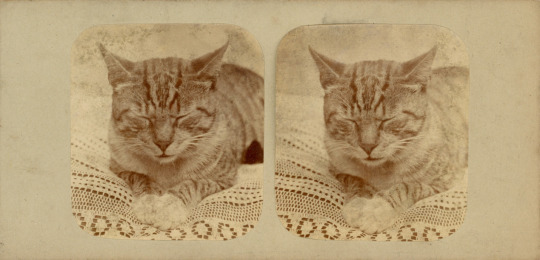
Early stereo close-up of cat. Photographer unknown. Circa 1860
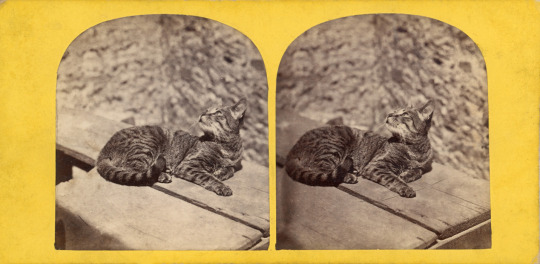
Early stereoview of cat likely taken with single lens sliding stereo camera. Photographer unknown. Circa 1860
collection : Jeremy Rowe | src Arizona Photography Alliance
#caturday#cat#chat#katze#stereographic card#stereocard#stereo view#stereograph#kitten#gatto#gato#gatitos#cats on tumblr#cat portrait#1860s#kitties
94 notes
·
View notes
Text

“We often learn from photographs how a family has lived” (Willis 11-13).
I believe this quote from the reading means that we can find out what kind of places people used to live just by looking at a photograph. Lived, does not necessarily only mean where people physically lived; it can also show under what conditions they lived, how many people they were living with, whether it was in a healthy environment, etc. The people shown in the photo found online and people in the reading are all African American people. The time period that people from the online photograph were living in was the late 1800s, and the family from the reading, was living a few decades later (1959). We can tell by the dates of these photos segregation was still happening. The family from the reading seems like they were living a decent life; dressed nicely, however, the family from the other photo does not seem to be dressed as nice, and they do not have shoes on. There are many objects in both the photographs and the subject would be family. I would say they probably hired someone to take a family photo for them because it is a photo of a whole generation after all; they might have wanted to preserve some memories, same for the photo from the reading; they wanted to preserve some memories. The audience for the photos would most likely be their family and the people who helped take their photos. The audience now is the public. It is fascinating to see photos from the past because they documented what happened in the past and what was going on in families. What I found weird was that mostly everyone kept a straight face in the photos, but photography was relatively new back then, so I think they might have just taken the photography with seriousness.
References:
Strohmeyer & Wyman, These Are the Generations of Ham, 1895.
Willis, Deborah. Picturing US: African American Identity in Photography. New P., U.S.
0 notes
Text
Marshall Family Plot at Laurel Grove North Cemetery-Savannah, Georgia
I was searching through public domain photos and found this Laurel Grove North Cemetery stereograph of the Marshall Family Plot. Stereographs consist of two nearly identical photographs created to produce a three-dimensional image to be viewed through a stereoscope. Frequently, the images are mounted on paper about the thickness and flexibility of modern-day card stock.
I have photographed one…

View On WordPress
0 notes
Video
President in doorway of West Divide Creek ranch house - "Skip" in lap (LOC) by The Library of Congress
Via Flickr:
President in doorway of West Divide Creek ranch house - "Skip" in lap c1905 September 12. 1 photographic print on stereo card : stereograph. Notes: Photo shows Teddy Roosevelt sitting in the doorway of log cabin, reading a book, with the dog Skip in his lap. Title from item. Copyright by Alexander Lambert. Published in: Presidential Pets / Niall Kelly (1992), p. 50. Subjects: Roosevelt, Theodore,--1858-1919--Travel--Colorado. Dogs--Colorado--1900-1910. Reading--1900-1910. Format: Stereographs--1900-1910. Photographic prints--1900-1910. Rights Info: No known restrictions on publication. Repository: Library of Congress, Prints and Photographs Division, Washington, D.C. 20540 USA, hdl.loc.gov/loc.pnp/pp.print Higher resolution image is available (Persistent URL): hdl.loc.gov/loc.pnp/stereo.1s02164 Call Number: STEREO PRES FILE - Roosevelt, Theodore--Hunting--1905 [item]
#Library of Congress#dc:identifier=http://hdl.loc.gov/loc.pnp/stereo.1s02164#Cabin#Theodore Roosevelt#flickr
0 notes
Photo

“No. 145. Chinese Restaurant, San Francisco. Cal.” c. 1875. Stereograph by J.J. Reilly (from the collection of the Oakland Museum of California).
A Long-forgotten Jackson Street Restaurant
The albumen stereograph card by pioneer photographer John James Reilly held by the Oakland Museum of California (“OMCA”) depicts the exterior of a three-story building in San Francisco’s Chinatown. Taken from an elevated position across the street and at a diagonal to the building, Reilly captured two façades visible from the street. The exterior balcony of the third floor shows at least ten statues of venerated deities placed just outside the balcony’s railing across the entire width of the building’s frontage on Jackson Street. Numerous potted plants wrap around the front and half of the balcony’s length along the side of the building facing out onto Washington Place (also known as “Fish Alley” to non-Chinese). Two different pairs of lanterns are suspended from under the portion of roof overhanging the balcony. Elaborately carved wooden floral pieces frame the center pair of doors opening to the balcony. A common form of pennant can be seen hanging from an iron cross-mast mounting to one of the narrow columns supporting the cantilevered portion of the roof, probably advertising a tearoom at the topmost floor.
At the second floor’s balcony, English language signage appears above a circular, center window which the OMCA curator has erroneously discerned as “Chin Ying Low” over the word “Restaurant." The barely discernible Chinese characters on the glass lanterns of the second floor balcony further attest to the restaurant’s name as 聚英楼 or, Cantonese pronunciation, “Jeuih Ying Lauh”).
The Bishop directory of 1875 confirms, however, that the name of the restaurant’s name was “Choy Yan Low,” and its address listing read as follows: “restaurant SE cor [sic] Washington alley and Jackson.” According to the maps of that era, the southeast corner of the intersection corresponded to 633 Jackson St.
The OMCA’s estimate about the year during which Reilly took his fascinating stereograph of the Chinese restaurant proved remarkably accurate – to the precise year. As the 1876 Langley directory discloses, the restaurant had moved and reestablished itself one block away as the “Choy Yan Lou, 2 Washington Alley.”

The Wells Fargo Chinese business directory of 1878 confirmed its ongoing operation with a listing in Chinese as follows: 聚英樓號酒晏茶居德和街享, literally “Choy Ying Low, wine, quiet tea house – Tuck Wo Street [i.e., Washington Place]” (canto: “Jeuih Ying Lauh houh jau nan cha geui Duck Wo gaai heung;” pinyin: “Jùyīng lóu hào jiǔ yàn chá jū dé hé jiē xiǎng”).

A portion of “No. 145. Chinese Restaurant, San Francisco. Cal.” c. 1875. Stereograph by J.J. Reilly (from the collection of the Oakland Museum of California).
Another restaurant was located next door to the Choy Yan Low on the 600-block of Jackson Street. In the far left of the Reilly photo, the frontage of the “Yen Nem & Co Restaurant” (燕南樓; canto: “Yeen Nahm Lauh”) can be seen on the easterly adjacent side of the building in which Choy Yan Low was located. For a half dozen years, the Yen Nem restaurant would continue to appear in listings variously and at alternate addresses as the “Yennem Low (Chinese) restaurant,” at 629 Jackson or “Yen Nam Low & Co.” and the “Yen Nem Low restaurant” at 627 Jackson. The vertical signage along the left border of the photo is barely visible. However, other photos of this block (notably by Carleton Watkins), show that the sign advertised arrangements for literally “Manchurian meat and vegetarian banquets” or follows: “燕南樓包辦滿漢葷素歌筳酒席”(pinyin: Yàn nán lóu bāobàn mǎn hàn hūn sù gē tíng jiǔxí; canto: “Yeen Nahm Lauh bau baan wuhn hon fun soe gaw ting jauh jik”). With the presence of two major restaurants, ground floor retail stores, and the New Chinese Theater at 623 Jackson Street, this block of old Chinatown must have constituted a vibrant, commercial entertainment strip.

A detail from the 1885 map prepared for the San Francisco Board of Supervisors from the Cooper Chow collection (at the Chinese Historical Society of America).
Reilly’s inclusion in his photograph of the western frontage of the Choy Ying Low building on Washington Place (now known as Wentworth), provides an intriguing hint about the three men seen to the right of the photo. Two individuals are standing outside the doorways to the ground floor spaces on Washington Place; a third man stands closer to the curb. All three men appear to be doing nothing except observing the street. Based on the detail of the 1885 map for this corner, their positioning coincides with the presence of gambling establishments and a pawnshop -- around the corner from the restaurant’s entrance and a couple of doors south on Washington Place, as would be shown a decade later on the city’s 1885 vice map. Thus, it would not be unreasonable to infer that Reilly’s photo captured two to three “look-see” men standing guard for the alleyway’s gambling operators .
With the presence of two major restaurants at 633 and 631 Jackson, ground floor retail stores, and the Cantonese opera offered by the New Chinese Theater at 623 Jackson Street, this block of old Chinatown must have constituted a vibrant, commercial entertainment strip during the late 1870′s.
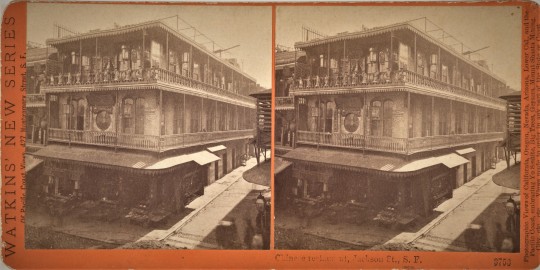
“Chinese restaurant, Jackson St., S.F. 3753″ c. 1875. Stereograph by Carleton Watkins (from the public domain collection of the Getty Museum). Judging from the angle of the sunlight along the length of Washington Place at the right of the frames, the photo was taken around mid-day.
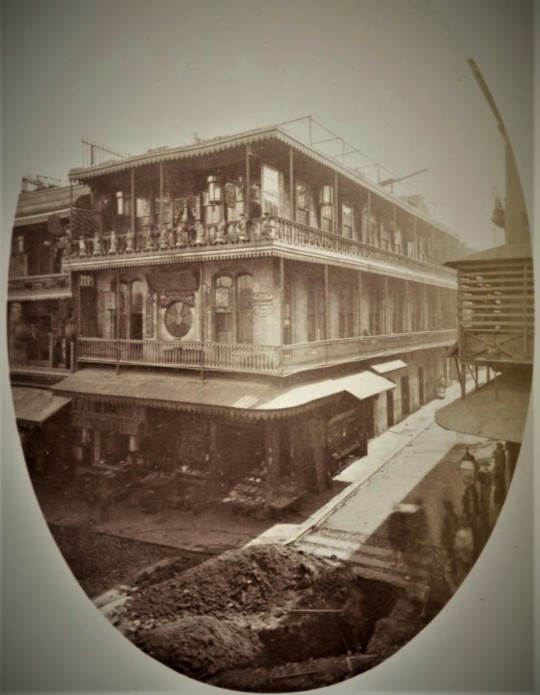
Choy Ying Low, c. 1875. Photograph by Carleton Watkins (from the collection of the California State Library). This print captures a wider angle view of the restaurant than the ones used for the stereograph.
Sometime in 1880, the Choy Ying Low apparently ceased operations. By the following year, the Sing Sing poultry store occupied the 2 Washington Alley address, and another legendary Chinese restaurant had passed into history.
[updated: 2022-9-23]
#Choy Ying Low#San Francisco Chinatown#Jackson St.#Washington Place#OMCA#Yen Nem Low#New Chinese Theater#J.J. Reilly#Carleton Watkins
0 notes
Photo


“The No. 5457, one of the latest type locomotives of the Pennsylvania Railroad” by the Keystone View Co., 1927 (minor processing by Jake Wood, 2023).
For a wonder, this image included the details from the reverse!
Though the details note that 5475 is a 4-6-2 engine, colloquially Pennsy called this a K4 Class engine, built by Juniata Locomotive Works in Altoona.
I also like the note that PRR ran a Fort Pitt Limited. I had no idea.
Library of Congress Prints & Photographs Online Catalog
Stereograph Card Collection
1 note
·
View note